PROTECT YOUR DNA WITH QUANTUM TECHNOLOGY
Orgo-Life the new way to the future Advertising by AdpathwayAs a keen birder, wildlife photographer, former safari guide, and optics reviewer at BBR (Best Binocular Reviews), I know firsthand how the right spotting scope can transform your birding experience. While binoculars are essential for birding (especially at closer ranges), a spotting scope with its extra magnification offers a somewhat different experience.
They are particularly adept at identifying things like shorebirds and raptors at long distances or smaller species in more detail at closer distances. In this guide, I’ll break down the most important aspects I look for when choosing a spotting scope for birding as well as digiscoping birds, highlighting key features that I look for and sharing my top recommendations.
Featured Product: Swarovski ATX/STX 85mm Spotting Scope (Best of the Best)
Check the price and availability of the Swarovski ATX/STX 85mm Modular Objective Lens
The ATX/STX spotting scope series features an innovative modular design that I absolutely love as it enables you to very easily switch eyepieces, switch between angled and straight eyepieces, use both your eyes, or even switch to digiscoping, all with just a simple button press and a twist. This design completely enhances the versatility of your scope. What is more, this flexibility also extends to the objective lenses, and you can swap out all the eyepiece modules with any of the four available objective modules (65mm, 85mm, 95mm, 115mm).
For days out hiking, the compact 65mm is ideal, while the 95mm and giant 115mm objectives excel in low light and digiscoping.
Optics:
As you would expect from Swarovski Optik, especially at this price level, the ATX/STX system delivers an outstanding and, in my opinion, unbeatable optical performance. Clarity, contrast, and color fidelity are top-tier, with edge-to-edge sharpness and no notable chromatic aberration or vignetting. You also get a wide field of view across the entire magnification range, which negates the need for a separate wide-angle lens.
- Why it’s the Best: The best optics money can buy, modular design, superior build quality, and the resultant image quality and user experience make the Swarovski ATX/STX 85mm the ultimate birding spotting scope.
- Key Features for Birders:
- Fluoride HD Glass: Provides crystal-clear images with excellent color accuracy.
- Interchangeable Eyepieces: Wide-angle and high-magnification options.
- Wide Field of View: Good for tracking moving birds
- Dual Focus Mechanism: Quick and precise focusing.
- Extremely high-level build quality with a modular design allows unparalleled flexibility
- Robust, Sealed Body: Fully waterproof and fog-proof.
- Digiscoping Ready: Compatible with Swarovski’s digiscoping adapters.
- Cons:
- Eyewatering price tag – Out of reach for many and probably overkill for casual birders
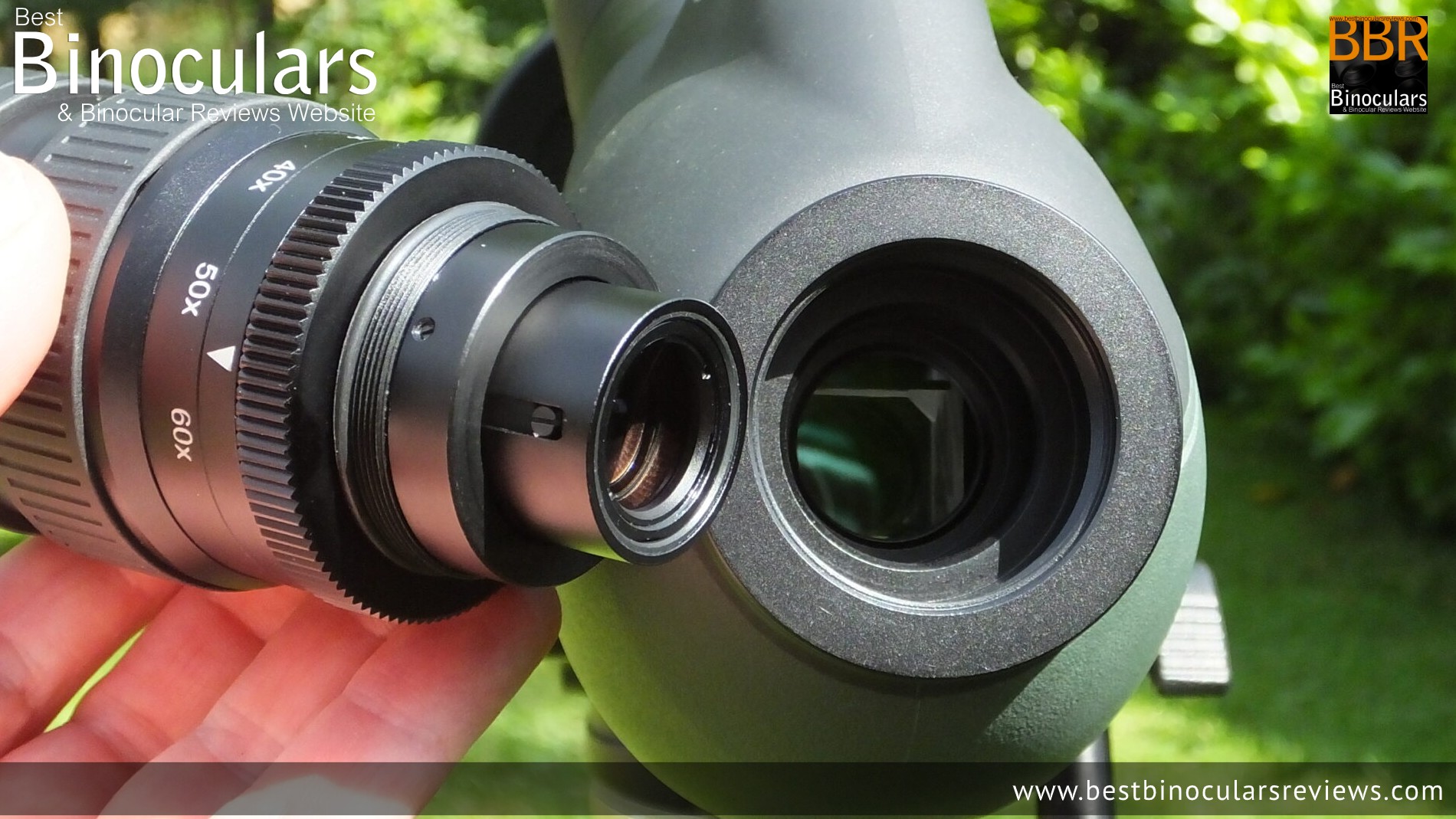 Removable 20-60x Zoom Eyepiece
Removable 20-60x Zoom EyepieceWhat to Look for in a Great Birding Spotting Scope
- Magnification & Objective Lens: Most birding scopes range from 15-60x magnification, with an objective lens between 55-115mm. A larger lens provides better light gathering for bright images but adds weight and size to the package.
- Field of View (FOV): A wider FOV is crucial for tracking birds in motion. Wide-angle eyepieces help maintain a broader view.
- Glass & Coatings: High-quality optics with features like ED or HD glass elements in the lenses can drastically improve image quality and reduce unwanted effects like chromatic aberration (very important at high magnifications and especially digiscoping), while special coatings on the lenses and prisms enhance light transmission and improve quality. Do not be tempted by cheap optics with minimal or no coatings, as the image will suffer, and is something that is especially noticeable at high magnifications.
- Eyepiece Options: The better quality scopes come with removable and, thus, interchangeable eyepieces, allowing customization for different birding scenarios.
- Close Focus: Don’t only think of long distances – A low close-focus distance can be great for studying birds in a nearby bush or feeder.
- Weatherproofing: Waterproof and fog-proof bodies are important for bad conditions but are also a definite sign of quality and prevent small particles like dust from entering the system.
- Digiscoping Compatibility: If you enjoy bird photography, look for scopes with large objectives and good quality (metal) eyepieces with plenty of eye relief that makes it much easier and more secure to attach a digiscoping adapter onto.
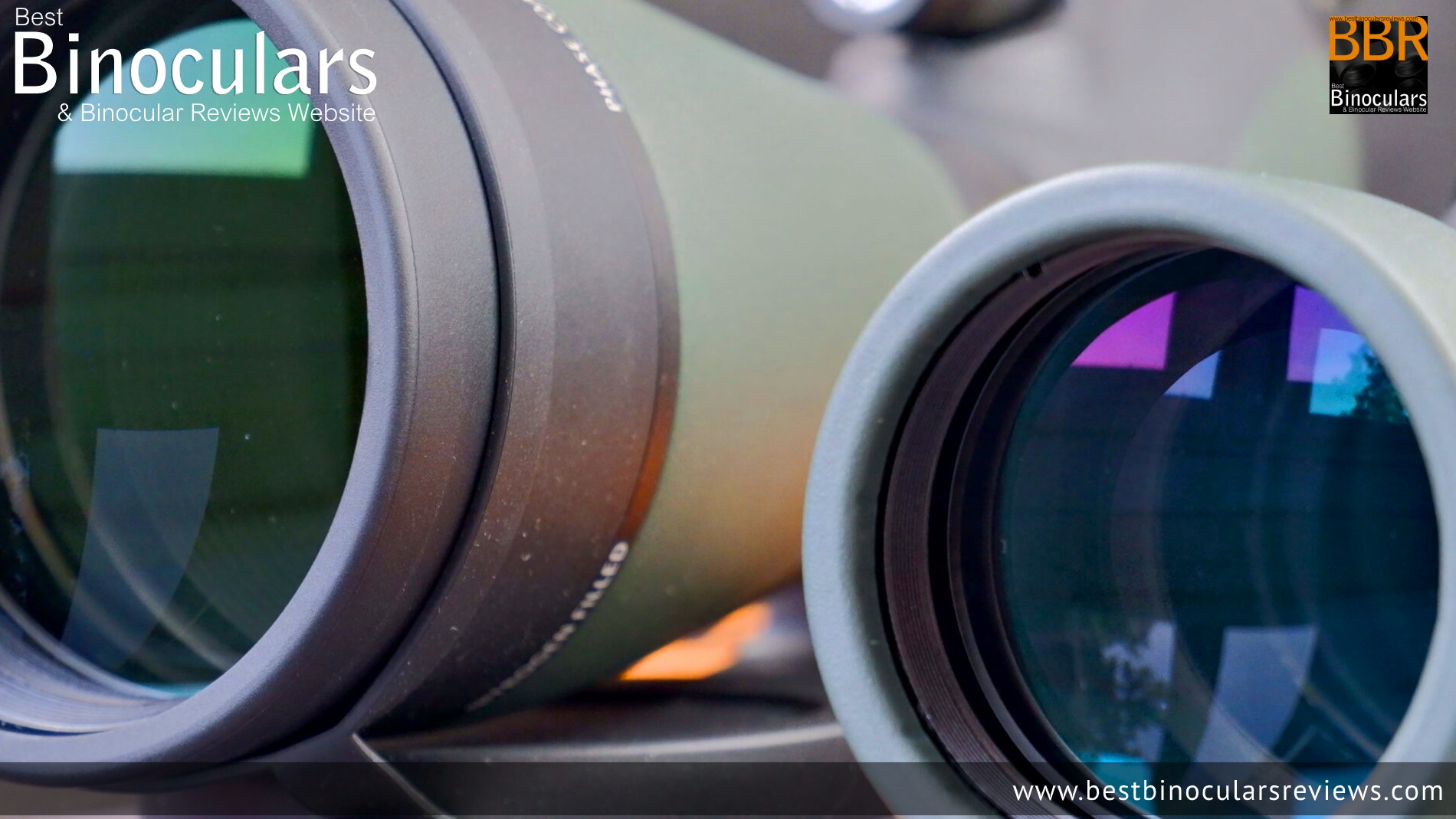 56mm vs 80mm Objective Lens
56mm vs 80mm Objective LensObjective Lens Sizes:
Spotting scopes come in various objective lens sizes, typically ranging from around 50mm to 100mm. A larger objective lens gathers more light, producing a brighter and clearer image, especially in low-light conditions like dawn or dusk. However, larger lenses also mean increased weight and size, making them less portable.
For birders, the ideal lens size you need depends on your needs, and there is no clear-cut right or wrong option. But as a guide:
- 50-60mm: Best for portability and travel.
- 70-80mm: A balance between image brightness and weight.
- 90-100mm: Ideal for digiscoping and low-light use but makes for a much bigger and heavier scope.
Choosing the right size depends on whether you prioritize brightness and detail or portability and ease of use.
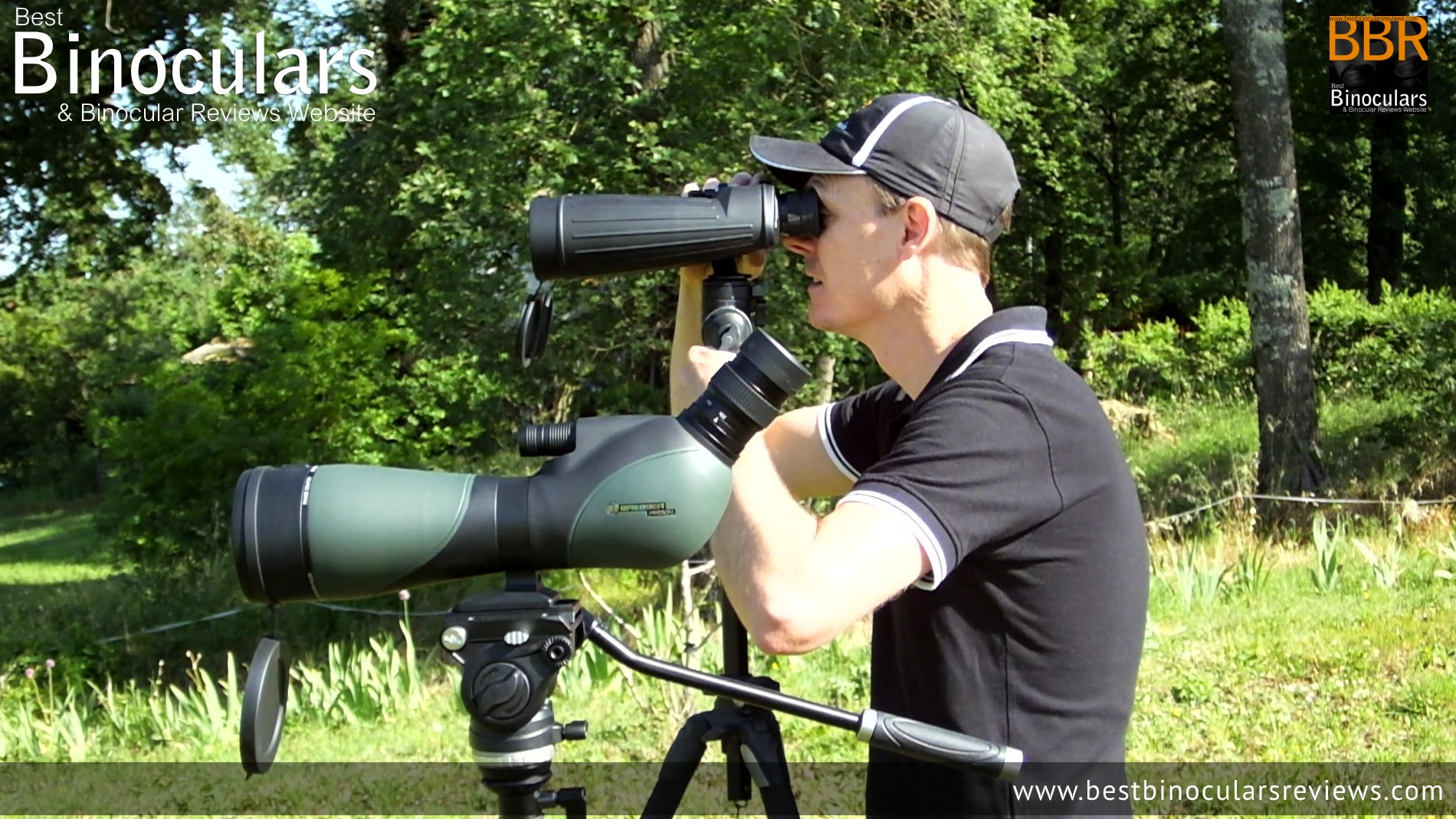 Angled vs straight through observation
Angled vs straight through observationChoosing Between a Straight and Angled Spotting Scope:
As well as the points listed above, when selecting the right spotting scope for your needs, you need to decide between a straight or angled body design. Each configuration has its own advantages and disadvantages, depending on how and where you plan to use it:
Straight Spotting Scopes
A straight spotting scope features an eyepiece that is in direct alignment with the objective lens. This design resembles a traditional telescope and is favored by many users for its more intuitive operation.
Advantages of Straight Spotting Scopes
- Easier Target Acquisition – Since the eyepiece is in line with the objective lens, it is generally quicker to locate and follow moving subjects, such as birds in flight or wildlife on the move.
- Better for Beginners – The straightforward design makes it more intuitive, especially for those new to spotting scopes.
- Ideal for Use from Elevated Positions – When observing from a raised platform, tower, or vehicle, a straight scope allows for a more natural viewing position.
- More Convenient for Digiscoping on Flat Surfaces – Attaching a camera for Digiscoping is often simpler with a straight scope when working from a tripod at standing height.
- Comfortable for People of Similar Heights – When multiple users share a scope without frequent height adjustments, a straight design is more practical.
Disadvantages of Straight Spotting Scopes
- Less Comfortable for Extended Use – Prolonged observation can strain the neck and back, especially when mounted lower or used from a seated position.
- More Challenging for Upward Viewing – Observing birds in tall trees or celestial objects like the moon is more difficult, as you must either tilt your head at an awkward angle or somehow get underneath the eyepiece (I sometimes use a chair and sit under the scope).
Angled Spotting Scopes
An angled spotting scope has an eyepiece that is positioned at an angle (usually 30, 45-degree or 90-degrees) relative to the objective lens. This design offers greater flexibility for different viewing scenarios.
Advantages of Angled Spotting Scopes
- More Comfortable for Prolonged Use – Allows for a more relaxed and natural viewing posture, especially when seated or observing for extended periods.
- Better for Shared Use – Multiple users of varying heights can use the scope without needing to constantly adjust the tripod height.
- Ideal for High-Angle Viewing – Easier to look up into trees, mountains, or even astronomical objects without straining the neck.
- Lower Tripod Height Needed – Can be mounted lower, providing better stability and less tripod shake in windy conditions.
- Great for Digiscoping from Lower Angles – When using a camera for Digiscoping, an angled scope can allow more comfortable positioning, particularly when photographing subjects lower than the observer.
Disadvantages of Angled Spotting Scopes
- Slower/ More Difficult Target Acquisition – Because the eyepiece is angled, it can take longer to locate and track fast-moving subjects.
- Less Intuitive for Beginners – Requires some adjustment time, especially for those new to spotting scopes.
- More Difficult to Use from Elevated Positions – When viewing from a standing position on a hill, a vehicle, or a raised platform, an angled eyepiece may feel awkward.
- May Require an Additional Finder Scope – Some users add a small finder scope to help locate subjects more quickly before using the main eyepiece.
Which is Best for Digiscoping?
Both straight and angled spotting scopes can be excellent for digiscoping, but the choice depends on your primary shooting angle and comfort level:
- Straight scopes work well for subjects at eye level and when using a tripod at standing height.
- Angled scopes provide more flexibility when shooting from lower positions and allow for a more comfortable viewing experience during extended digiscoping sessions.
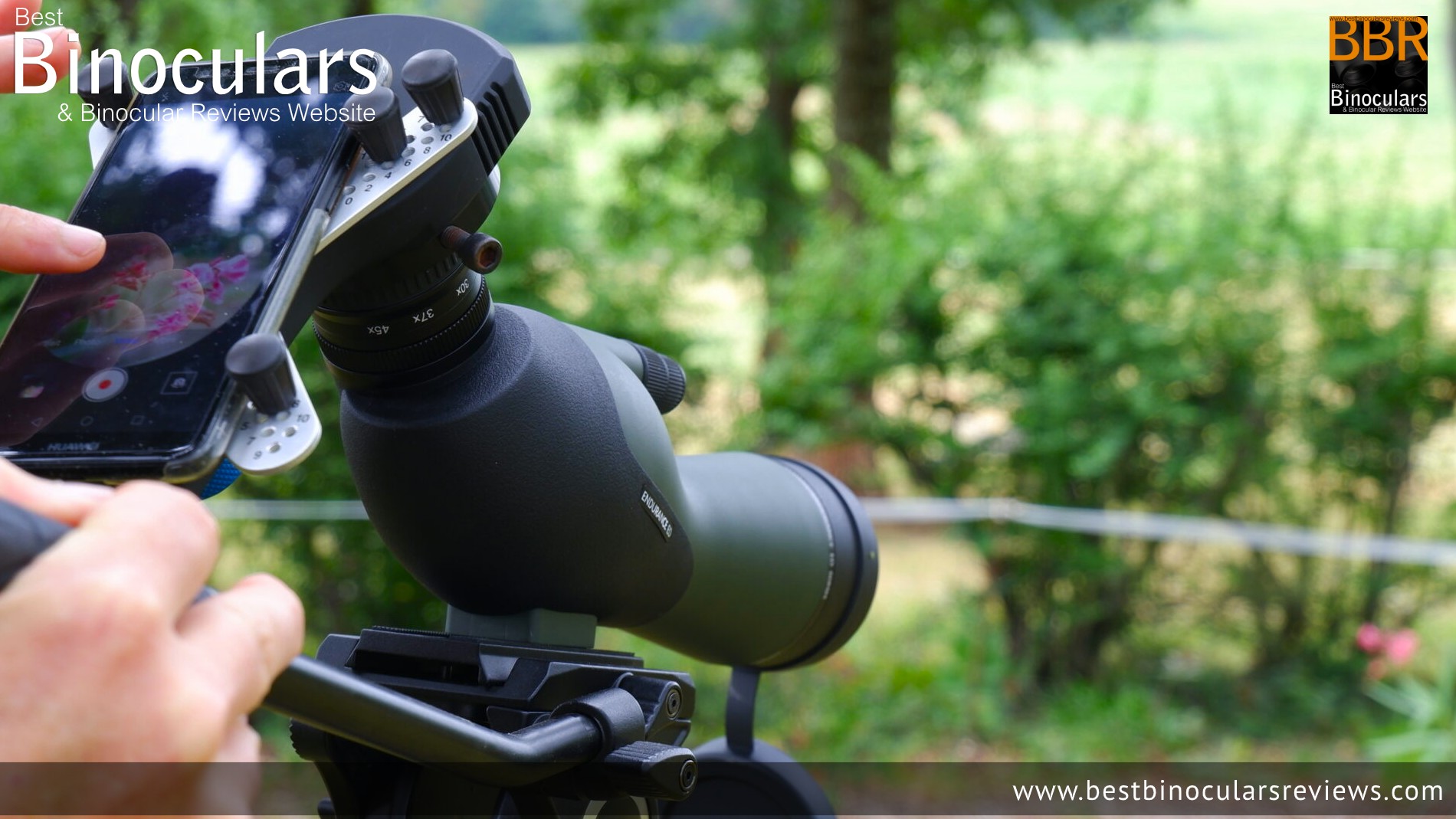 Digiscoping with the Hawke Endurance ED Spotting Scope
Digiscoping with the Hawke Endurance ED Spotting ScopeIn Summary
- Choose a Straight Spotting Scope if:
- You prioritize quick target acquisition, especially for moving subjects.
- You plan to use your scope primarily from a standing position or elevated location.
- You are a beginner and/or looking for a more intuitive design.
- You will primarily use your scope for level / downward observation.
- Choose an Angled Spotting Scope if:
- You want a more relaxed setup, good for extended birdwatching or digiscoping sessions.
- You frequently share your scope with people of different heights.
- You need to observe high-up subjects (e.g., birds in tall trees, astronomy).
- You want more stable/ lower tripod positioning with less height adjustment.
Both types of scopes have their place in birding and digiscoping. By carefully considering your intended use, comfort, and environment, you can make the best choice to enhance your outdoor viewing experience.
5 Top Birding Spotting Scopes
1. Kowa TSN Prominar Spotting Scope (High-End)
Why It’s Great for Birding: Kowa TSN spotting scopes are widely regarded as one of the best spotting scopes available, especially in the birding community. It features a pure fluorite crystal objective lens that delivers unparalleled image sharpness and color fidelity. Its dual-focus system allows for both quick and fine adjustments, making it easy to lock onto birds at any distance. Despite its powerful optics, the lightweight magnesium alloy body ensures it’s not overly cumbersome for field use.
Birders who demand the highest optical quality will appreciate the bright, contrast-rich images even in low-light conditions. The scope is fully waterproof and nitrogen-purged, ensuring durability in all weather conditions. Its compatibility with Kowa’s range of digiscoping adapters makes it an excellent choice for photographers looking to capture stunning bird images.
Check the price and availability of the Kowa TSN-99A PROMINAR Pure Fluorite
- Highlights:
- Pure fluorite crystal objective lens for incredible sharpness
- Lightweight magnesium alloy body
- Dual focus system
- Pros:
- Unparalleled optical performance
- Customizable with different eyepieces
- Ideal for serious birders
- Cons:
- High cost
 Testing the Tiny Bresser Pirsch 9-27×56 Gen II Spotting Scope
Testing the Tiny Bresser Pirsch 9-27×56 Gen II Spotting Scope2. Bresser Pirsch Gen II 9-27×56 Spotting Scope (Compact Travel Scope)
Why It’s Great for Birding: The Bresser Pirsch Gen II is a compact and lightweight spotting scope, making it perfect for birders on the move – be that on long walks and/or for taking on any boring holiday or adventure. With its 9-27x magnification and 56mm objective lens, it provides a good balance between portability and performance. While the smaller objective lens limits low-light capabilities, its fully multi-coated optics ensure bright and sharp images in daylight conditions.
The ergonomic design makes it easy to carry, and its wide field of view at lower magnifications helps track fast-moving birds. For birders who prioritize mobility and need a spotting scope that fits into a small backpack, the Pirsch Gen II is an excellent choice.
Check the price and availability of the Bresser Pirsch 9-27×56 Generation II
- Review Source: Bresser Pirsch 9-27×56 Gen II Spotting Scope Review
- Highlights:
- Compact and lightweight design
- Fully multi-coated optics for bright, clear images
- Waterproof and nitrogen-filled for durability
- Pros:
- Excellent for portability and travel
- Good image clarity for its size
- Affordable price point
- Cons:
- Smaller objective lens limits low-light performance
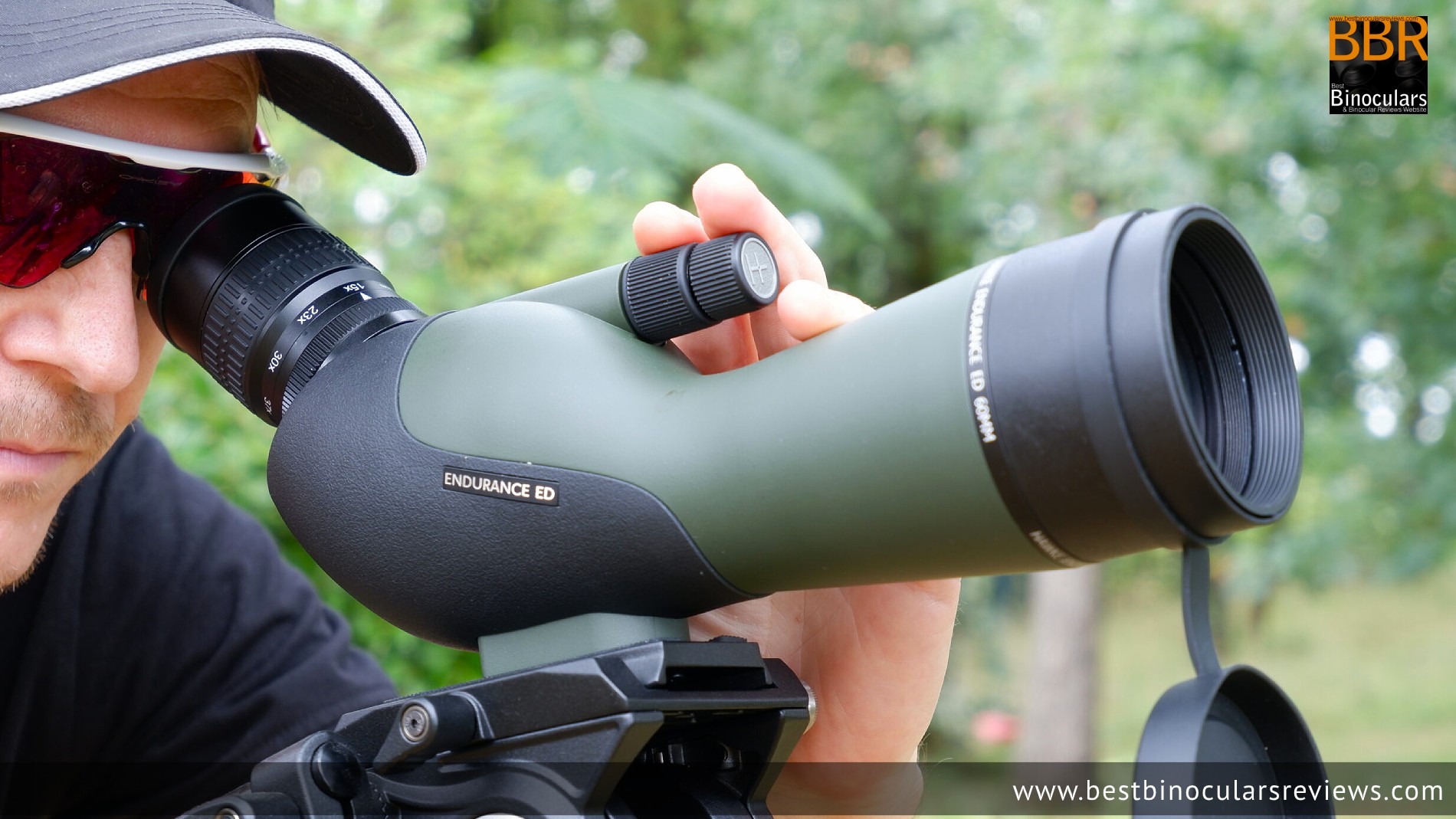 Hawke Endurance ED Spotting Scope
Hawke Endurance ED Spotting Scope3. Hawke Endurance ED 15-45×60 Spotting Scope (Great Value Mid-Range Option)
Why It’s Great for Birding: The Hawke Endurance ED offers excellent optical performance at a competitive price, featuring extra-low dispersion (ED) glass to minimize chromatic aberrations and ensure high contrast and color accuracy. Its 15-45x zoom range provides ample magnification for detailed observations, while the 60mm objective lens keeps the scope lightweight and easy to handle.
This scope is fully waterproof, fog-proof, and built with a rubber-armored body for durability in the field. With its wide field of view and smooth focus adjustment, birders will find it easy to follow and identify birds at various distances.
Check the price and availability of the Hawke Endurance ED Compact
- Review Source: Hawke Endurance ED 15-45×60 Spotting Scope Review
- Highlights:
- ED glass for reduced chromatic aberration
- Dual focus system
- Wide field of view
- Pros:
- Affordable compared to high-end scopes
- Good optical clarity and color accuracy
- Compatible with digiscoping adapters
- Cons:
- Less light-gathering ability compared to larger scopes
4. Celestron Regal 100 F-ED Spotting Scope (Great for Digiscoping)
Why It’s Great for Birding: The Celestron Regal 100 F-ED is an excellent value option, especially if you are interested in digiscoping. It features a large 100mm ED objective lens that captures exceptional detail and brightness. Its dual-speed focusing mechanism allows for precise control, which is crucial for capturing sharp images, be that through a camera or your smartphone.
The supplied eyepiece for the scope offers a 22-67x magnification range, giving you a wide range and one of the most powerful at the top end. The Regal 100 is built for rugged outdoor use with a magnesium-alloy chassis and full waterproofing and despite the size, it is reasonably lightweight. For bird photographers looking to take their digiscoping to the next level, this is an outstanding choice.
Check the price and availability of the Celestron Regal 100 F-ED
- Highlights:
- Large 100mm objective lens for maximum light gathering
- ED glass for sharp and color-accurate images
- Rotating tripod collar for flexible positioning
- Pros:
- Exceptional brightness and clarity
- Excellent compatibility with digiscoping adapters
- Robust construction
- Cons:
- Large and heavy for travel
 Opticron MM3 60 GA ED Travelscope
Opticron MM3 60 GA ED Travelscope5. Opticron MM3 60 GA ED Travelscope (Mid-Size Option)
Why It’s Great for Birding: The Opticron MM3 60 GA ED is a fantastic travel spotting scope, combining lightweight design with excellent optical performance. The ED glass provides sharp and bright images, while the compact 60mm objective lens keeps it portable for birders on the go. Its interchangeable eyepiece system allows for flexibility in choosing magnification levels. I tested the scope with a 15-45x Eyepiece that offered 17-22mm of eye relief and a field of view between 63ft and 138ft wide at 1000 yards (depending on the magnification setting).
Check the price and availability of the Opticron MM3 60 GA ED Travelscope
Review Source: Opticron MM3 60 GA ED Travelscope Review
- Highlights:
- ED glass for high-quality image resolution
- Compact and lightweight for travel
- Fully waterproof and nitrogen-filled
- Pros:
- Easy to carry and set up
- Good balance between portability and performance
- Affordable for an ED glass scope
- Cons:
- Smaller objective lens affects low-light performance, especially at higher magnification settings
Final Thoughts
A good spotting scope is an excellent, almost essential tool for any serious birder, providing the magnification needed to study distant species in incredible detail. Whether you’re looking for the absolute best (Swarovski ATX/STX), or a high-end but more budget-friendly options like the Kowa, Hawke, and Celestron Scopes. For travel, the 60mm Opticron and Bresser Pirsch make great options.
If you’re also interested in digiscoping, make sure to choose a scope with high-quality optics, wide FOV, and as large an objective lens as you are willing to go with!









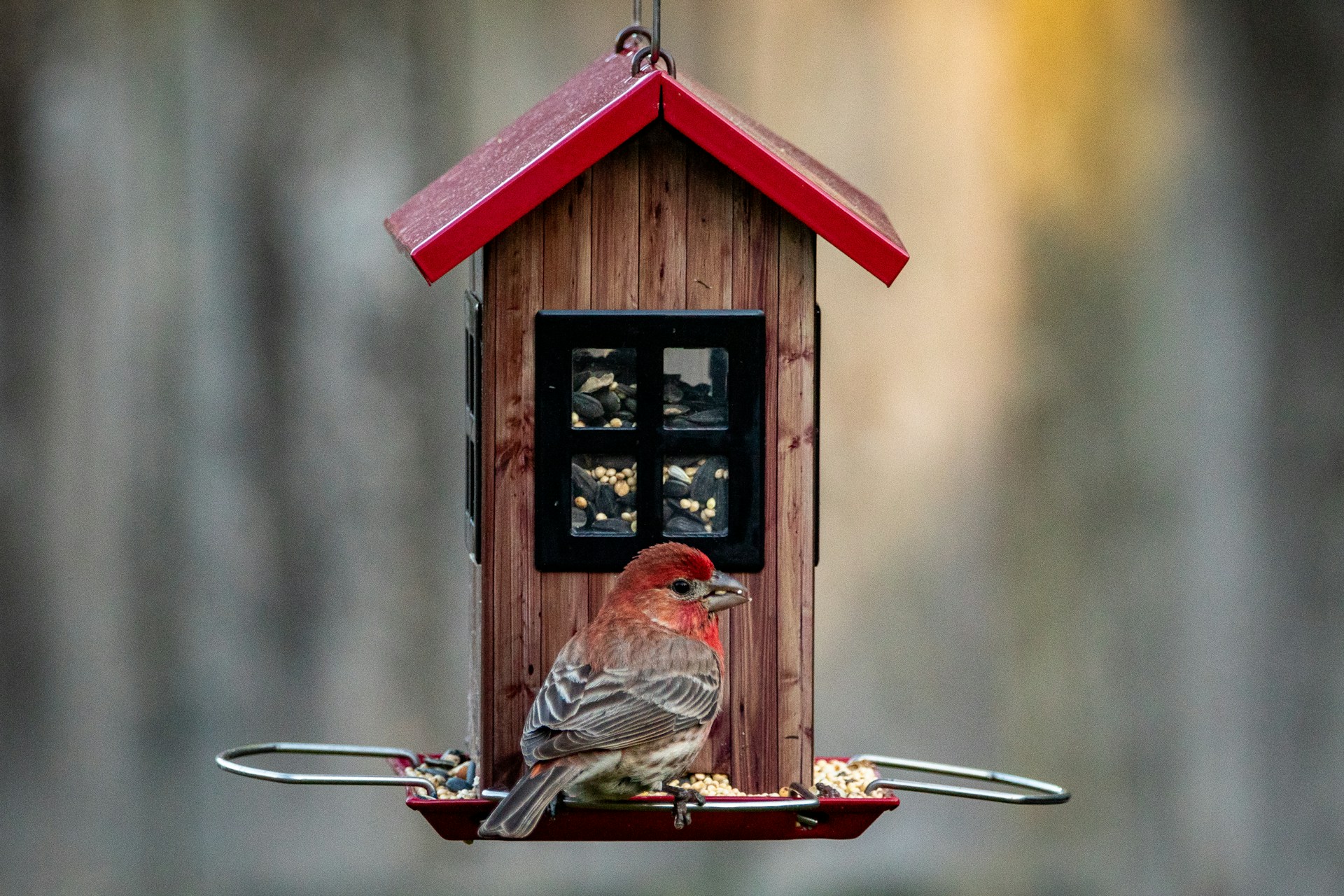














 English (US) ·
English (US) ·  French (CA) ·
French (CA) ·